If one sets out to break the law, one should dress as innocuously as possible, so as not to lose any chance of winning sympathy if caught. On the day in question, therefore, I was wearing clean, mild-mannered, slightly unfashionable clothes—faded jeans, a once-fancy green-striped shirt whose collar was beginning to wear away at the fold, a black sweater, and a camel-colored corduroy coat that had belonged to my boyfriend in college. I also wore sneakers, but they were for traction.
It was a mild, pre-spring Tuesday, which fooled some people into thinking they didn’t need a coat, but not me, who had been out in it earlier, walking the dog. The dog was home now, dozing off her breakfast, and I was back in the park with a camera. The camera was a decoy. If caught, I planned to say that I had spotted a red-winged blackbird while walking the dog and had returned to photograph it. This was true, as far as it went, and had the advantage of sounding not only perfectly legal but like the sort of thing that might, if pursued with enthusiasm, lead naturally to the crime I had in mind: to climb a tree in Prospect Park.
The trouble had started a couple of weeks earlier, with a certain young Eastern white pine. It stood a few paces from the sidewalk in the barbecuing area behind the monument to General Lafayette at Ninth Street and Prospect Park West. For four years I had passed it daily without noticing it, but lately, as if I were a teenager whose interest in the world had been altered by his hormones, I found I could not walk past without surveying it longingly. Its lower branches were so disposed as to give a clear view of its base forking, as it rose, into two parallel trunks, with a sturdy, almost horizontal branch issuing just at the fork, so low to the ground that one could easily imagine pulling oneself onto it.

It affected me like the sight of an attractive man whose shirt is unbuttoned a button or two lower than is decent; I felt restless and discontented afterward. You would scarcely have to climb such a tree; you could practically walk into it. I found myself daydreaming about sneaking back to it, sometime when the park had fewer people.
On this Tuesday, maybe because it was so mild, I had made up my mind at last to give in to temptation. I didn’t know for a fact that tree-climbing was against the law in Prospect Park. I didn’t want to know, because it seemed likely that it was—the city couldn’t be responsible for clumsy people falling to their deaths—and I wanted to be able to claim ignorance of the law with conviction. Of course I felt guilty and nervous. I doubted I would be able to convince the police I was a birder. My camera had no telephoto lens, for one thing. For another, although I owned a Sibley Guide to Birds, I almost never took it off the shelf. I did know, though, that red-winged blackbirds are as common as dirt and don’t call out for a special trip to the park to photograph them.
At nine-thirty, it was too early for schoolchildren and for all but the most organized mothers. The Chinese grandmothers had finished their morning t’ai-chi, but there were a few men and women out for a walk or a run. A parks police SUV trundled slowly along a paved footpath, on a patrol, perhaps, for dog walkers who hadn’t yet come to terms with the recent switch to Daylight Savings Time. I passed the Eastern white pine that had so attracted me. I felt I couldn’t climb it. It was unachievable for the same reason it had caught my eye—it was too public—like a handsome person hired by a bar’s management to stand near the door and seem to be a patron. My plan was to find a climbable tree in a less-frequented area. The park had hundreds, maybe thousands of trees; there had to be at least one that was both unpruned and unwatched.
Past a couple of baseball diamonds, at the foot of a gentle slope, I came to a pond where dogs less fastidious than mine sometimes swim. The so-called dog beach was still shut up with a winter barricade of wooden palings and end-to-end bicycle stands, though the warmth had eaten away most of the pond’s gray icing. A group of young people were taking samples of the pond water with plastic containers. They were standing in the wildlife zone, behind a fence that keeps out the public, the sort of fence I might soon have to jump over. They were probably no more than interns, but they had the serious air of people working in an official capacity, people with permission. I walked by as nonchalantly as I could. On the pond, a couple of buffleheads were sailing back and forth among the regular ducks. (I didn’t know they were buffleheads; I looked them up later, when I got home.) To make my cover story more plausible, I circled the pond until I came to a clearing within sight of the interns and took a few pictures. The buffleheads had white bellies and black backs, and their heads were black except for a top, rear quadrant of white—they were ducks colored like penguins, more or less. My pictures were terrible, I saw, so I took a few more.
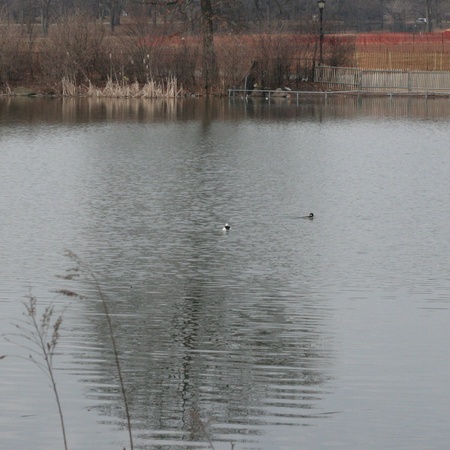
Also terrible. And then a few more. I realized I was temporizing and told myself to move on.
Beyond the pond, at the foot of a hill, I came to a road closed to traffic and a large clearing. Three mothers in polyester running outfits approached, pushing large strollers and taking deep, low strides in order to stretch their hamstrings. I did not make eye contact. To the right of the road was a Quaker cemetery, closed to the public. It was only visible when the trees had no leaves, as now. There was a good view of it from the hill to the left of the road, I had been told. I decided to try the hill. It was heavily wooded and would give me a second pretext; if I were caught in a tree and there were no birds around, I could say that I was trying to get a better view of the cemetery.
I ascended. A glimpse of a navy blue windbreaker tied to a torn piece of fencing briefly alarmed me, but in fact there were no people on the hilltop. It had many trees and two clearings. I thought of the reassuring vocabulary that a children’s book would have used: a thicket and two glades. I photographed a chipmunk who seemed to think I couldn’t see him because he was sitting in a pile of last year’s leaves just his color.

It occurred to me that early spring is a convenient time to search for a climbable tree, because no foliage obstructs the inspection of branches—not on the deciduous trees, anyway. On the other hand, if one were to find a suitable tree, the absence of leaves would make one rather visible. I had come to where the trees were thickest, as if they themselves would be able to hide me. Unfortunately, where trees are thick, they tend to grow straight up—lateral branches, blocked and overshadowed by neighbors, don’t survive—and I couldn’t find any footholds or even handholds. It came to me that I had run into this problem once before, long ago, when I was a teenager and used to lose afternoons in scrub forests on undeveloped land in a Massachusetts suburb. I should have remembered that dense woods are as a rule uninvitingly vertical.
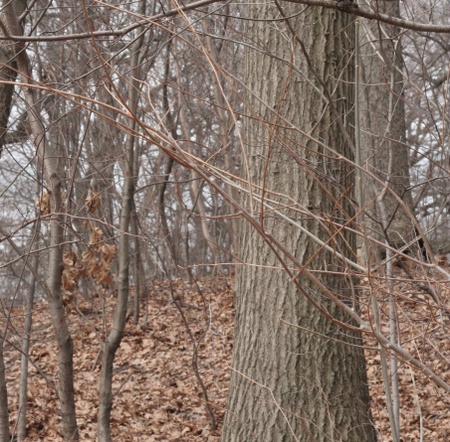
At last, on a clearing’s edge, I found a tree growing almost diagonally. It stood on a much-eroded slope; probably a storm had washed it from its anchor in middle age, and it had had to re-establish itself at an angle. It leaned toward a neighboring tree, which it nearly crossed, and I thought I might be able to start a climb by lodging myself between them. I checked the park’s ring road, visible below. Only runners and more strollers. I put one hand on the leaning tree, another on its neighbor, jumped, pushed, . . . and slipped back to earth. The leaning tree’s bark had come off in my hand, like an old scab. The bark’s underside was powdery and yellow, and the exposed wood was dry and brown-veined. I now remembered something else I’d learned in the suburban woods. When no trees have leaves, it isn’t easy to figure out which ones are dead, and therefore dangerously brittle.
If the tree had died recently enough, it might still be safe. While I was assessing it, a runner came up behind me. I started guiltily into a walk. After he passed me, I kept walking, momentum having reinforced my second thoughts. I would try a different patch of woods, north of the pond. Re-emerging into the meadow at the foot of the hill, I saw that the park was filling up. A blue-and-white city police van rolled along the closed road. A city police golf cart whined along a footpath. I felt sure they were taking note of me. It was discouraging. I wondered if I should come back another time—after dark, maybe, or at dawn.
I entered a new set of woods, where the paths were narrowly fenced, and found myself alone again. I remembered that I was pretending to be a birder and told myself there was no risk in staring at trees unabashedly, appraisingly, even at trees behind fences. Forbidden trees. How could anyone know my designs on them? I would choose my tree now, by daylight, and return under cover of darkness to have my way with it. Yet these trees, too, looked inaccessible. I began to suspect the park’s gardeners of systematically removing any branches that might give a climber a leg up. And then, turning a corner, I saw the candidate I had been imagining.
It was an American beech. (On the shelf at home beside my Sibley’s is an Audubon Society Field Guide to North American Trees.) The trunk had the shape of a low Y, and branches spread generously outward from each of the Y’s arms. I knew at once that it was climbable, because I saw at once that it had been climbed, often. Children had tattooed it with inscriptions, high up into its branches. “The trunks are favorites for carving and preserve initials and dates indefinitely,” I was to read in the Audubon guide later. Olga and Daneil had joined their names on October 27, no year given. Poo loved Dayyal.
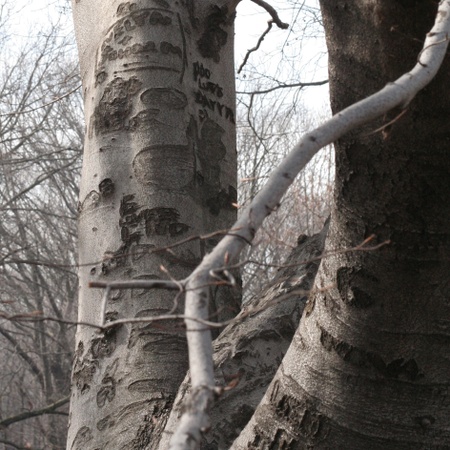
With the growth of the bark after carving, the letters had spread and blurred, like a note left in fluent ink on a piece of tissue paper. Along the path near the beech was a black metal fence to keep parkgoers from straying, but a boulder offered a step up, and the fence beside the boulder had a gentle, telltale bend, where the children had held it down as they jumped over.
While I was studying the tree, two young men in fleece jackets turned the same corner I had. I said hello a little too loudly and, tapping my camera, walked past them with a brisk manner that I hoped would remove any suspicion that I had been loitering. Their fleeces bore the insignia the parks department, and they were carrying the sort of small digital cameras with which people document scratches on their cars. Glancing behind me, nervously, as I walked unwillingly away, I saw that they were stopping before my beech tree. One of them pointed at it, then described with a gesture the shape of its branches. They were discussing it. It was a problem tree, evidently. Perhaps it was a problem because it attracted people like me. Or rather, not like me. It was young people in the flush of love who climbed this tree, at night with pilfered beer. Not thirty-nine-year-olds, late on a Tuesday morning, when respectable people are at work.
I waited in a meadow nearby for the two men to leave, then returned. I stood on the boulder, trying to work up the nerve to jump the fence. While I waited for courage, I photographed the trees’ graffiti. I photographed some of its leaves, yellow and curled but still in place from last fall, so that I would be able to identify the tree later in my Audubon. There was no sound but the buzzy shutter of my camera. It was just when I was beginning to think it was safe to break the law that an enormous hawk swooped down.
As it soared past I managed to get a picture—poorly framed, not quite in focus—of the blank, outstretched underside of one of its great wings and its soft, narrow body with gray, leathery claws.

In an elegant, up-curving arc, it alighted noiselessly on a tree a few yards away. It was enormous—maybe a foot and a half from beak to tail—but didn’t look full grown. The feathers on its head and breast were downy and unsettled, not sleek. From the rust color of its tailfeathers and the patternless white of its underwing, I figured out later that it was a red-tailed hawk. It cocked its head, as if it were listening to something, and I now heard a soft mewling I hadn’t noticed before, coming from the underbrush. Something young and small was complaining; maybe it had fallen from its nest. A small bird? A kitten? Its cries grew louder—unadvisedly, I thought. But then the hawk dipped its head, leaned off its branch, and flew carelessly away. It had lost interest.
I decided it was a portent. Why shouldn’t I cross a fence and climb a tree, when I had seen a creature so magnificent? I lifted a foot to step over . . . and I put it back down again. A middle-aged man in a denim jacket had turned the corner. He had almost caught me. Where had he come from? Why hadn’t I heard him? He didn’t seem to want to walk past me but turned away as if all directions were the same to him. I waited to see if he would leave, but half a dozen yards away he came to a standstill. I couldn’t figure out why at first. And then, of course, I did figure it out. (Indeed, when I retraced my steps a few days later to confirm some details in this essay, I found three men on the same stretch of path, standing in a row at a distance from one another, silently, as if waiting for a bus in the middle of the woods.) He wasn’t going anywhere anytime soon, I realized. He wasn’t likely to report me, but somehow I didn’t want to climb the tree in his presence. So I gave up and walked away.
Oh well, I thought. So much for a secret return to childish pleasures; so much for nature in the city. I crossed the wide lawn where I let my dog run off leash every morning. It was a bit muddy from the still-new thaw. It was strange that something as innocent as tree-climbing seemed shameful. It was a pity, in fact, because the best trees to climb are those in clearings, where sun encourages branches to open on all sides, and space allows them to take gentle angles rather than desperate, vertical ones. Yes, it was too bad, I thought to myself, and suddenly, to my dismay, the morning’s adventure seemed allegorical. I had allowed fear and shame to defeat me.
I looked up. Another American beech was before me, single and unimpeded in the long meadow. Instead of two upstretched arms, like a Y, it had more than a dozen, like an up-ended, absurdly well endowed squid. Its bark was whitish gray and faintly speckled, like an elephant’s skin, and the joints where the branches met the trunk were dimpled, like an underarm or the back of a knee. A parks department building was only a stone’s throw away, and its nearest door was propped open, probably for the sake of the fresh March air. Despite the open door I stepped into the tree.
The breathlessness that comes from the need to be sure of one’s footing was added to the breathlessness of wondering if I would soon hear a reprimand. But no one came out of the parks building, and I couldn’t afford to keep looking at its door, because I had to watch my feet and hands.
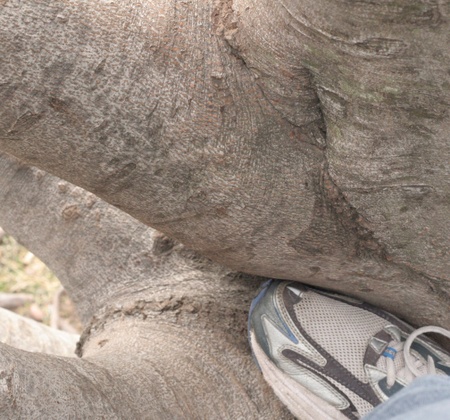
In a moment I forgot my anxiety. The tree itself made me feel secure. The bark was tough but smooth, and the curves of its limbs had an almost human proportion. Nothing feels as solid as a living branch; stone by comparison is brittle. I leaned into the tree’s arms to rest for a second, then climbed higher. To free a foot, I temporarily put my weight on a forearm and felt the bone inside my arm lying across the wood, causing a brief, delicate pain. My legs were a little shaky, from nerves, and there was soreness in my upper arms, from having pulled myself up by them. But my primary feelings were safety and, well, elevation.
Little was carved in this beech, perhaps because no one who climbed it was hidden, but at a perch where it felt natural to pause and look out over the grass, someone had written on the main trunk’s bark in Magic Marker: “Malcolm M’s Spot.” I understood why he felt like claiming it. A little higher up, in the same handwriting: “The Holy Tree.” I understood that, too. I liked it that Malcolm, whoever he was, hadn’t written merely for the pleasure of seeing his name or to record a love affair, that he had written to express his feelings about the tree itself. “The words beech and book come from the same root,” my Audubon guide says, “because ancient Saxons and Germans wrote on pieces of beech board.”
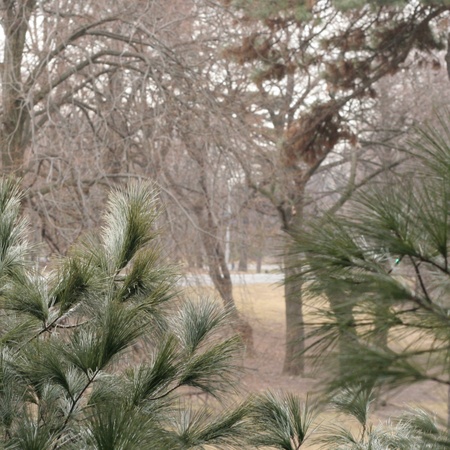
On my way out of the park, I climbed the Eastern white pine, too. It was higher, and therefore more of a thrill. The branches were so regular that it was like walking up a ladder. “The tall, straight trunks were prized for ship masts in the colonial period,” my Audubon reports. I was up in the rigging, as it were. To climb so high is a little like flying, and maybe dreams of flight are a species memory of the days when we lived in trees. The graffiti in the pine was not as interesting—pines are less mystical than beeches—but a recent climber had left a handful of pennies in the crotch of the tree, as if to reward the next visitor. I left them in place. As I dropped to the ground, a young woman was walking past on the sidewalk. In the usual New York way, she pretended not to see what she didn’t know what to think of. I took a fallen cone with me for a memento.








